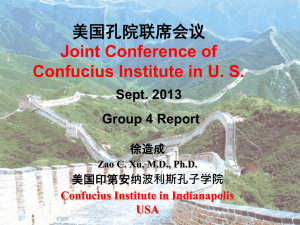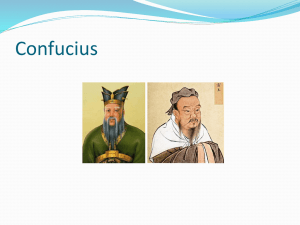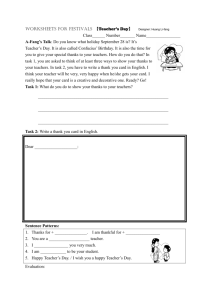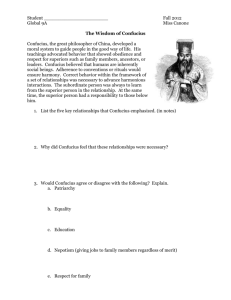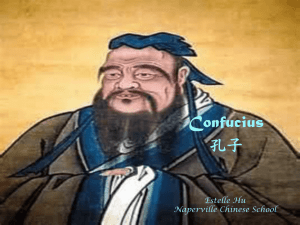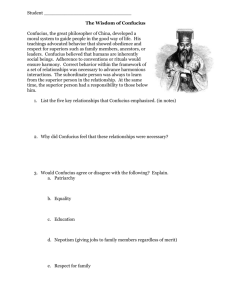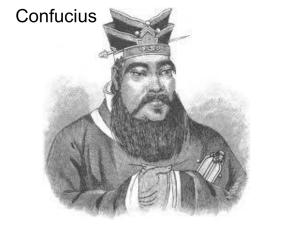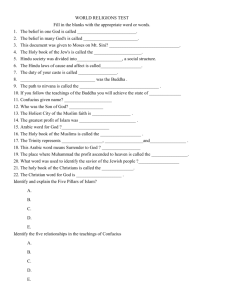Confucius PowerPoint
advertisement
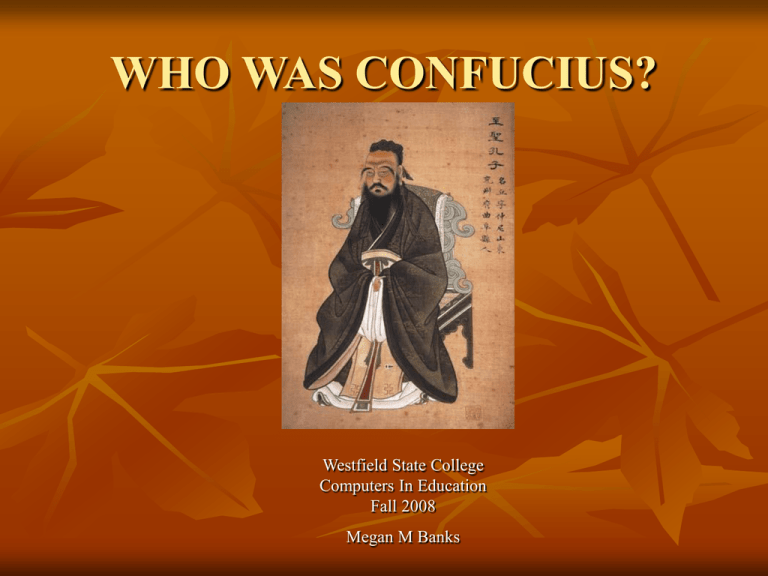
WHO WAS CONFUCIUS? Westfield State College Computers In Education Fall 2008 Megan M Banks Introduction You may have heard the name ‘Confucius’ before. If you have, you may even have heard some of his philosophies. But chances are pretty good that if you have heard of him, you’ve only heard it in the context of a joke. But the truth is that Confucius is an important figure in philosophy and in Chinese history. Through this WebQuest, you now you have a chance to learn about this man and his ideas. Tasks 1. Use the internet to answer the following questions: Who was Confucius? Where and when was he born? What were his philosophies on - good government? - proper conduct? - relationships between parent and child? - relationships between friends? - the relationship between husband and wife? - the relationship between ruler and subject? Do you think that Confucius’ ideas are relevant today? Why or why not? Tasks 2. Use your research to write a paper on Confucius and his philosophies. Process To complete this task, you will be working with partners. You will need a mouse operator and a pencil operator. The mouse operator will lead your team through the internet in search of information. The pencil operator will write down all the information you find that you think is important. Each day that your team uses the computer, you will trade jobs. Process (cont.) 1. Use the links provided to find the information you need to answer these questions. 2. Use index cards to record and organize your information. Once you have all of the information you need, agree on a system for organizing your cards (example: by question or by paper format). 3. As a team, write a paper on Confucius. Remember your writing process. • • • • • Prewrite – Write down your ideas. What do you want to include in this paper? What can you leave out? How should your paper be structured? Rough Draft – Use lined paper and skip every other line. This will give you room to go back and make adjustments and corrections. Peer Review – After your second rough draft, find another team that will trade with you. Be constructive in your comments of your classmates’ work and be willing to take suggestions. Be sure to check spelling, punctuation and capitalization. Revise / Edit – Make sure that you have agreed, as a team, on the content and format of your paper. Final Copy – The final copy should be typed in Times New Roman size 12 font, double-spaced. All team members’ names should be in the upper right hand corner along with the date. Tips Remember that you must use your own words! When you are taking notes, be sure that you have the correct information, but that it is written in an original way. You may use up to two quotes. Be sure to follow to rules of inserting a quotation! Your paper needs to have an introduction, body and conclusion! While writing your paper, be sure to keep in mind that you are not answering questions on a test. For example, if this WebQuest was about you and I wrote in my paper, “June 27, 2001,” it wouldn’t make any sense. However, if I wrote, “John Smith was born on June 27, 2001,” you know just what I’m talking about. Conclusion You have now learned about the great philosopher, Confucius! You have also practiced the paper-writing skills you have learned in your Language Arts classes. Even better, you have done all of this working as a team. Hopefully you worked together in a way that would make your teacher and Confucius proud. You are one step closer to being prepared to move on to fifth grade (and discuss philosophy!). Evaluation You will be evaluated based on the following criteria CATEGORY 4 3 2 1 Writing Organization Each section in the paper and a clear beginning, middle and end 4 out of 5 of the sections have a clear beginning, middle and end 3 out of 5 of the sections have a clear beginning, middle and end 2 out of 5 of the sections have a clear beginning, middle and end Spelling and Proofreading 1-2 spelling errors after using spell check No more than 4 spelling errors. No more than 6 spelling errors. More than 6 errors. Content and Accuracy All the facts in the paper are accurate. Most of the facts in the paper are accurate. Some of the facts in the paper are accurate. Many of the facts are innacurate. Attractiveness and Organizatioin The paper has outstanding formatting and well-organized information The paper has attractive formatting and well-organized information. The paper has well organizedinformation. The paper’s formatting and organization of the material are confusing to the reader. Internet Resources Below you will find a list of resources on the Web that you can use to find the information you need to complete this task. History for Kids! Encyclopedia.com KidsPast.com MrDonn - Ancient China for Kids URI Kids - World Religions - Confucianism Globaled.org Department of Education Frameworks History and Social Science Curriculum Framework Grade 4: North American Geography with Optional Standards for One Early Civilization Strand Topic : Grade 4 Learning Standards Building on knowledge from previous years, students should be able to: Grade 4: 4.1. Optional Standards for Ancient China, c. 3000-200 BC/BCE 4.5. Identify who Confucius was and describe his writings on good government, codes of proper conduct, and relationships between parent and child, friend and friend, husband and wife, and subject and ruler. (H, C) English Language Arts Curriculum Framework Composition Strand Topic : Writing Grades 3-4: 19.11. For informational/expository writing: Write brief summaries of information gathered through research. Credits This WebQuest/PowerPoint was developed by Megan M. Banks in the fall of 2008, as part of a class on Recent Development in Computer Education offered by Westfield State College. Department of Education Frameworks can be found at http://www.doe.mass.edu/frameworks/current.html Graphics http://commons.wikimedia.org/wiki/Main_Page
